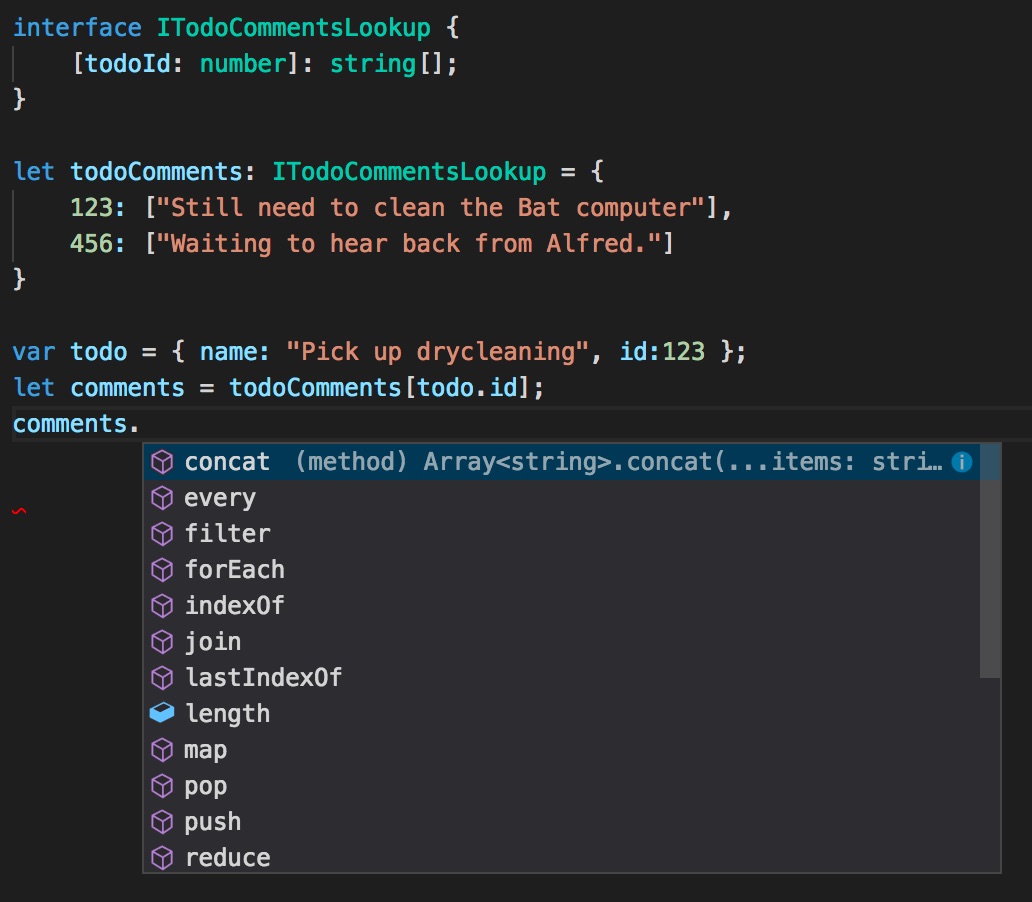原文链接:https://leanpub.com/essentialtypescript/read#leanpub-auto-custom-types
1. 使用interface定义新的类型
1.1. 定义interface
interface Todo {
name: string;
completed: boolean;
}1.2. 使用interface
var todo: Todo = {
name: "Pick up drycleaning",
completed: false
};
1.3. 遵守interface 协议
var t1: Todo = {};
var t2: Todo = {
name: "Pick up drycleaning"
};
这两个变量定义不合法,编译器会报错。因为,它们没有遵守 interface Todo 规定的协议,属性不完整。
1.4. 强制类型转换
var t1 = <Todo>{};这种写法告诉编译器 t1 符合 Todo 接口。虽然它不符合,但编译器不会报错。
1.5. optional 属性
interface Todo {
name: string;
completed?: boolean;
}
var t2: Todo = {
name: "Pick up drycleaning"
};
completed 后面有个问号,指明:
1. completed 属性可有可无;
2. 如果有这个属性,必须是boolean类型。
所以,t2 没有completed属性,但它是符合 Todo 接口的。
1.6. 在接口中定义function
interface ITodoService {
add(todo: Todo): Todo;
delete(todoId: number): void;
getAll(): Todo[];
getById(todoId: number): Todo;
}
注意,函数名前面不用写 function 。
2. 使用interface描述function
2.1. 定义函数 interface
function 本身就是Object,函数体是它的一个属性,当然,它也可以有其他的属性。
interface jQuery {
(selector: string): HTMLElement;
version: number;
}
1. 这个interface定义一个function接口,它模拟了 jQuery(selector) 这个函数。
2. 注意第二行,定义了一个没有名字的函数,括号中是参数声明,后面是返回值类型。没想通为什么要这么写,先背下来,反正就得这么写。
3. 第三行定义了一个属性 —— version。
2.2. 使用函数interface
说明:
1. 上图中,第七行定义了一个函数,函数名是 $,它遵从 jQuery 接口。
2. 第11行使用刚刚定义的 $ 函数,获取 id="container" 的DOM element。
3. 第12行,此时,TypeScript 可以推断出element的类型。
3. 给已有的interface添加属性
下面的代码模拟了 jQuery 的 data() 方法:
interface jQueryElement {
data(name: string): any;
data(name: string, data: any): jQueryElement;
}
interface jQuery {
(selector: (string | any)): jQueryElement;
fn: any;
version: number;
}
var $ = <jQuery>function(selector) {
// Find DOM element
};
var todo = { name: "Pick up drycleaning" };
var element = $('#my-element');
element.data('todo', todo);
var savedTodo = element.data('todo');
如果我们加上如下代码,会给 jQueryElement 添加 todo() 方法:
$.fn.todo = function(todo?: Todo) {
if(todo) {
$(this).data('todo', todo);
}
else {
return $(this).data('todo');
}
}interface jQueryElement {
data(name: string): any;
data(name: string, data: any): jQueryElement;
todo(): Todo;
todo(todo: Todo): jQueryElement;
}
可以这么写:
interface jQueryElement {
data(name: string): any;
data(name: string, data: any): jQueryElement;
}
interface jQueryElement {
todo(): Todo;
todo(todo: Todo): jQueryElement;
}
4. enum
interface Todo {
name: string;
state: number; /* New=1, Active=2, Complete=3, Deleted=4 */
}
function deletTodo(todo: Todo) {
if(todo.state != 3) {
throw "Can't delete incomplete task!";
}
}
enum TodoState {
New = 1,
Active = 2,
Complete = 3,
Deleted = 4
}
interface Todo {
name: string;
state: TodoState;
}
function deletTodo(todo: Todo) {
if(todo.state != TodoState.Complete) {
throw "Can't delete incomplete task!";
}
}5. 匿名类型
回顾一下前面写的 totalLength 函数:
function totalLength(x: (string | any[]), y: (string | any[])): number {
var total: number = x.length + y.length;
return total;
}
function totalLength(x: {length: number}, y: {length: number}): number {
var total: number = x.length + y.length;
return total;
}
{ length: number } 定义了一个匿名的 interface。
6. Indexer
第2行代码,它给 [ ] 定义了明确的signature,有了这个定义,最后一行才会出现上下文提示,TypeScript 才知道 comments 变量是个 string[ ] 。




























 800
800

 被折叠的 条评论
为什么被折叠?
被折叠的 条评论
为什么被折叠?








